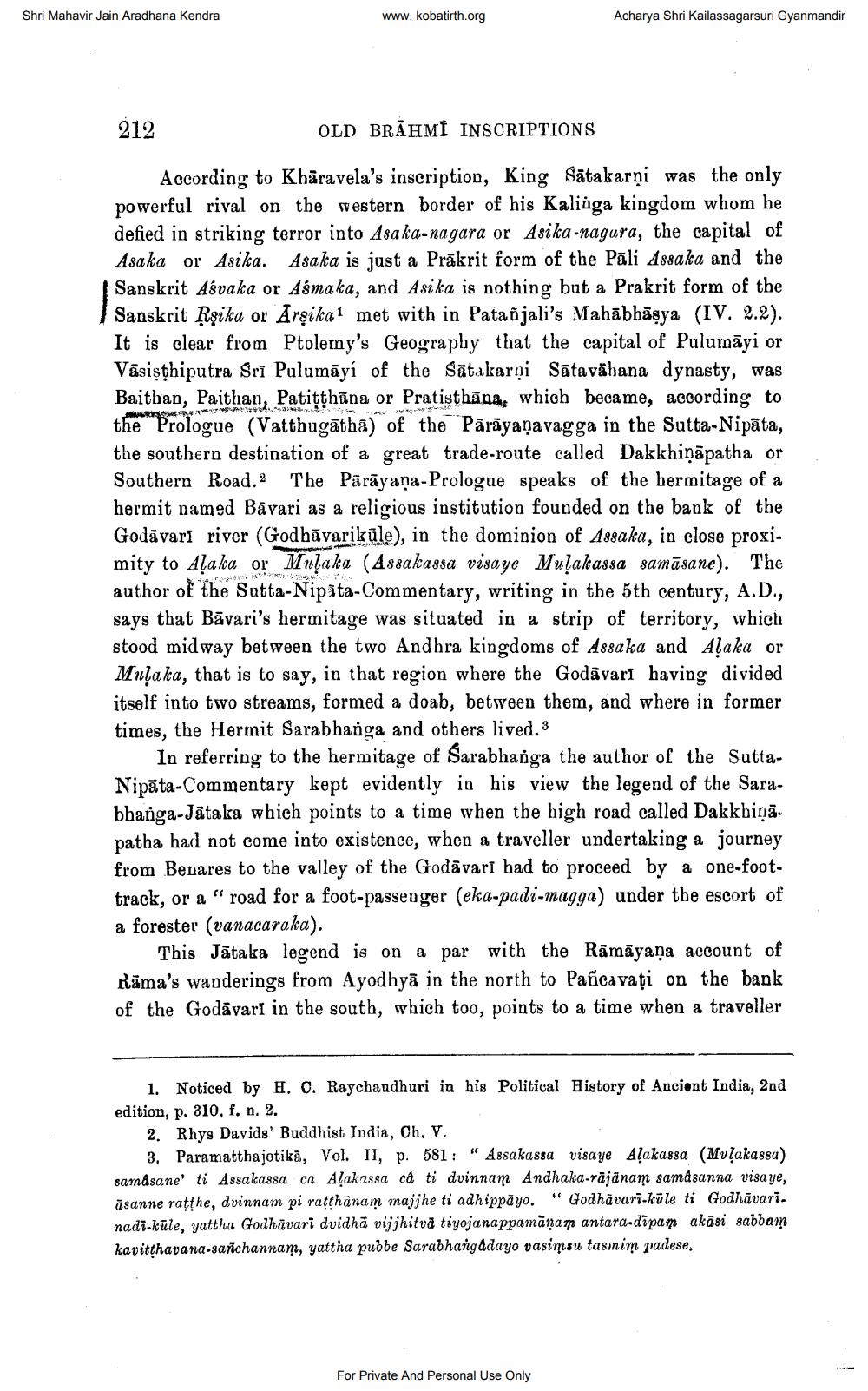________________
Shri Mahavir Jain Aradhana Kendra
www.kobatirth.org
Acharya Shri Kailassagarsuri Gyanmandir
212
OLD BRAHMI INSCRIPTIONS
NY
HA
According to Khāravela's inscription, King Sātakarņi was the only powerful rival on the western border of his Kalinga kingdom whom he defied in striking terror into Asaka-nagara or Asika-nagura, the capital of Asaka or Asika. Asaka is just a Prākrit form of the Pāli Assaka and the Sanskrit Asvaka or Asmaka, and Asika is nothing but a Prakrit form of the Sanskrit Rşika or Arşikai met with in Patañjali's Mahābhāşya (IV. 2.2). It is clear from Ptolemy's Geography that the capital of Pulumāyi or Vāsisthiputra Sri Palumāyí of the Satakarņi Sātavāhana dynasty, was Baithan, Paithan, Patițýhāna or Pratisthāna, which became, according to the Prologue (Vatthugātha) of the Pārāyaṇavagga in the Sutta-Nipāta, the southern destination of a great trade-route called Dakkhiņāpatha or Southern Road.2 The Pārāyana-Prologue speaks of the hermitage of a hermit named Bavari as a religious institution founded on the bank of the Godāvari river (Godhāvarikūle), in the dominion of Assaka, in close proximity to Aļaka or Mulaka (Assakassa visaye Mulakassa samāsane). The author of the Sutta-Nipita-Commentary, writing in the 5th century, A.D., says that Bāvari's hermitage was situated in a strip of territory, which stood midway between the two Andhra kingdoms of Assaka and Alaka or Muļaka, that is to say, in that region where the Godāvarı having divided
into two streams, formed a doab, between them, and where in former times, the Hermit Sarabhanga and others lived. 3
In referring to the hermitage of Sarabhanga the author of the SuttaNipāta-Commentary kept evidently in his view the legend of th bhanga-Jātaka which points to a time when the high road called Dakkbiņā. patha had not come into existence, when a traveller undertaking a from Benares to the valley of the Godāvari had to proceed by a one-foottrack, or a "road for a foot-passenger (eka-padi-magga) under the escort of a forester (vanacaraka).
This Jātaka legend is on a par with the Rāmāyaṇa account of Rāma's wanderings from Ayodhyā in the north to Pañcavați on the bank of the Godavarī in the south, which too, points to a time when a traveller
1. Noticed by H. O. Raychaudhuri in his Political History of Ancient India, 2nd edition, p. 310, f. n. 2.
2. Rhys Davids' Buddhist India, Ch. V.
3. Paramatthajotikā, Vol. II, p. 581 : " Assakassa visaye Aļakassa (Muļakassa) samasane' ti Assakassa ca Alakussa ca ti dvinnam Andhaka-rājānam samásanna visaye, āsanne ratthe, dvinnam pi ratthanam majjhe ti adhippayo. "Godhavari-kūle ti Godhāvari. nadi-kūle, yattha Godhāvari dvidhā vijjhitvà tiyojanappamānam antara-dīpam akāsi sabbam kavitthavana-sañchannam, yattha pubbe Sarabhangadayo vasimsu tasınim padese,
For Private And Personal Use Only




